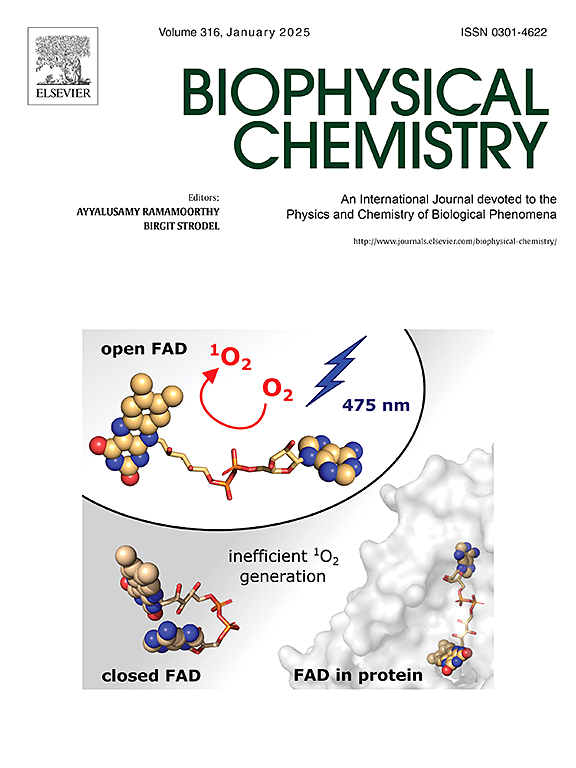Molecular mechanisms of Lobeline-mediated inhibition of lysozyme amyloidogenesis: A synergistic approach using biophysical and cheminformatics techniques
IF 2.2
3区 生物学
Q2 BIOCHEMISTRY & MOLECULAR BIOLOGY
引用次数: 0
Abstract
Numerous pathological conditions, collectively termed amyloidosis, are associated with the aggregation of misfolded proteins under stressed physiochemical conditions. Natural compounds capable of modulating protein aggregation or disassembling preformed fibrils hold promise as potential therapeutic candidates for treating aggregation-related diseases. In this study, we aim to examine the binding interaction and effectiveness of Lobeline (Lob), a piperidine alkaloid, in preventing the formation of acid-denatured Lysozyme (Lyz) amyloid using various spectroscopic, cheminformatics and imaging techniques. Steady-state and time-resolved fluorescence measurements confirm a direct interaction between Lyz and Lob with a binding constant of ∼106 M−1 with a 1:1 binding stoichiometry. The association has been found to be spontaneous and is driven by entropy involving non-electrostatic interactions. Molecular Docking shows that Lob stabilizes Lyz by hydrophobic and hydrophilic interactions. The anti-amyloid properties of Lob in Lyz amyloid fibrils are assessed through a range of in vitro techniques, including turbidity measurement, dynamic light scattering (DLS), Thioflavin T (ThT) fluorescence, Circular Dichroism studies and Field Emission Scanning Electron Microscopy (FESEM) imaging. These studies demonstrate that Lob halts the fibrillation of acid-treated Lyz at the nucleation stage by providing alternative pathways for hydrogen bonding and other weak interactions with key amino acid residues necessary for the formation of oligomers and fibrils.

红叶碱介导的溶菌酶淀粉样蛋白形成抑制的分子机制:使用生物物理和化学信息学技术的协同方法
许多病理条件统称为淀粉样变性,与应激物理化学条件下错误折叠蛋白质的聚集有关。能够调节蛋白质聚集或分解预先形成的原纤维的天然化合物有望成为治疗聚集相关疾病的潜在治疗候选者。在这项研究中,我们旨在利用各种光谱、化学信息学和成像技术研究胡椒碱生物碱Lobeline (Lob)的结合相互作用和有效性,以防止酸变性溶菌酶(Lyz)淀粉样蛋白的形成。稳态和时间分辨荧光测量证实了Lyz和Lob之间的直接相互作用,结合常数为~ 106 M−1,结合化学计量为1:1。这种联系是自发的,是由涉及非静电相互作用的熵驱动的。分子对接表明,Lob通过疏水和亲水性相互作用稳定Lyz。通过一系列体外技术,包括浊度测量、动态光散射(DLS)、硫黄素T (ThT)荧光、圆二色性研究和场发射扫描电子显微镜(FESEM)成像,评估了Lyz淀粉样蛋白原纤维中Lob的抗淀粉样蛋白特性。这些研究表明,Lob通过提供与低聚物和原纤维形成所必需的关键氨基酸残基的氢键和其他弱相互作用的替代途径,在成核阶段阻止了酸处理的Lyz的纤颤。
本文章由计算机程序翻译,如有差异,请以英文原文为准。
求助全文
约1分钟内获得全文
求助全文
来源期刊

Biophysical chemistry
生物-生化与分子生物学
CiteScore
6.10
自引率
10.50%
发文量
121
审稿时长
20 days
期刊介绍:
Biophysical Chemistry publishes original work and reviews in the areas of chemistry and physics directly impacting biological phenomena. Quantitative analysis of the properties of biological macromolecules, biologically active molecules, macromolecular assemblies and cell components in terms of kinetics, thermodynamics, spatio-temporal organization, NMR and X-ray structural biology, as well as single-molecule detection represent a major focus of the journal. Theoretical and computational treatments of biomacromolecular systems, macromolecular interactions, regulatory control and systems biology are also of interest to the journal.
 求助内容:
求助内容: 应助结果提醒方式:
应助结果提醒方式:


